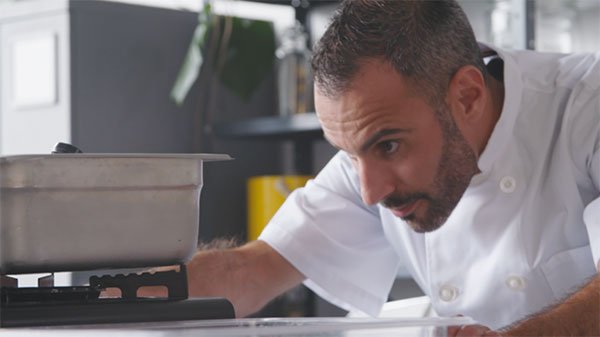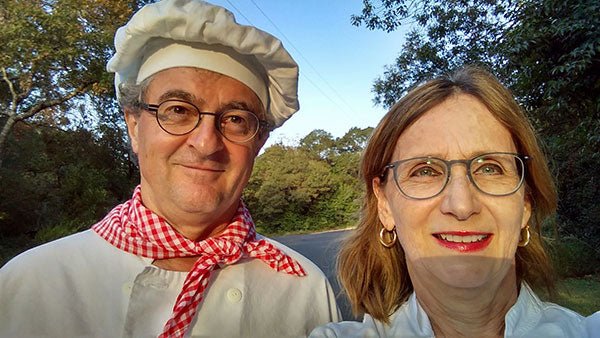
Ilda Costa-Sarnicki with her “Sun Kissed” Sao Jorge at 5 weeks, conceived on National Cheese Day, 2021. She plans to age half of it for 6 months and enjoy the second half on National Cheese Day, 2022.
Ilda works full time as an RN in a Neonatal Intensive Care Unit. When she isn’t working, she reads and plans her many projects – cooking, making cheese, baking bread and gardening. She takes photographs of her food and you will see here that her photos are incredible.

Blue Cheese, Bacon, and Pear Galette that I made from a recipe in Artisan Cheese Making at Home.
About her work and her cheese making, she told us,
“At work, I feed babies their mothers milk and watch them grow and develop … at home I make cheese and watch it shrink and develop … my life is balanced! Lol. I do love that even after a stressful set at work, the maintenance activities associated with cheese making and fermentation projects are actually grounding and stress reducing.
Even my adult daughter with special developmental needs who rarely goes to our basement asks to go turn the cheeses. It’s probably because she gets to choose a beverage from the basement fridge and sits in a cool environment while I wipe, turn, assess temperatures and humidity, but I like to think that she also feels the tranquility of these activities.”
Ilda’s Story
I was born in Pico, one of the Azores islands and grew up with fresh cheese made almost daily by my mom.
I moved to Canada as a young adult and didn’t have my mom’s fresh cheese for 16 years. My first time returning to the Azores, I enjoyed my mom’s fresh cheese and she gave me powdered rennet to bring back to my home in Canada so that I could make my own.
I enjoyed the experience and shared my fresh cheese with my family. Then, about 5 years ago, my “bonus” daughter, who had occasionally enjoyed my fresh cheese, gave me Mary Karlin’s Cheese Making at Home, saying that she thought I was ready for new recipes. (A bonus daughter is what most people call a step-daughter. I detest the “step” title. Instead, I feel so lucky that by marrying my husband I also received the bonus of another daughter in my family.)
Within two weeks, I had read the book from cover to cover and ordered a feta cheesemaking kit and started procuring cultures. One month later, I had made feta, ricotta, and mascarpone and I was hooked!

Made my Mom’s fresh cheese to celebrate Canada Day. It’s garnished with red pepper sauce (as is served on fresh cheese in the Azores), maple leaves and red currants from my garden.
My Cheeses
So far, using cow’s milk, I’ve made these types: feta, ricotta, mascarpone, blanco, fresco, halloumi, paneer, cream cheese, brie, edam, jack, pepper jack, farm house cheddar, tomme, manchego, saffron infused manchego, robiolini, camblu, buttermilk blue, gouda, Coeur de Neufchâtel, Camembert, Saint Marcellin, Raffine, Morbier, Reblochon, Saint Paulin, São Jorge, Gruyère, Stilton, Tete de Moine, Roquefort, Asiago Pepato, Parmesan, Desert Sunset, Taleggio, Oscypek.

Saint Marcellin. They’re quite recent. I still have 2 wrapped in ramekins waiting for a special date this month.

My first Roquefort twins from pasteurized store-bought cow’s milk. I made the wonderful flavour and creaminess last longer by freezing nugget sized chunks to grate over salads and steaks.

Farmhouse chive cheddar and my first successful waxing. Donated my chocolate fondue pot to the “cheese cause” and was greatly rewarded!
With cow and goat milk: mixed milk Morbier. With goat milk: chèvre, Brin D’Amour, Valençay, feta, Crottin, robiola, Banon.
With cow milk and thistle rennet- Cardoona.
My first regular repeat is feta. In fact, I don’t buy feta any more.

I showed viewers how to make feta on a Portuguese tv show. I used buttermilk as the culture, as it was more accessible to Portuguese homemakers as they usually already have rennet at home.
My second repeat is a São Jorge type. I use annatto in my version and call it Sun-Kissed São Jorge. I took a piece of my first São Jorge cheese back home to share with my family and compared it to the real deal from our neighboring island – São Jorge. That’s when I decided to adapt mine and called it Sun-Kissed as the name São Jorge is DOP.

My first Sun Kissed Sao Jorge. I made it on my birthday one year then served it on my birthday a year later.
My third repeat is a tomme. I call mine Tomme de Newcombe (after my street) and I love pairing it with my garden fresh heirloom tomatoes in the summer.
I also occasionally repeat the Oscypek type cheese which is an adaptation of a Polish mountain cheese made in a special wooden mold. I join the small tapered end cheeses into a heart shape and call it “Mountain Love” as my husband is Polish and we were married on a mountain … cheesy? Oh, yes!!
Challenges:
Fun but failed: Serra da Estrela type.

These are an example of my pride in eating my mistakes. They were supposed to be the Portuguese “Serra da Estrela” type cheese, made with thistle rennet and no proper recipe. They were fun to create and eat despite the result being more like a slightly bitter cousin of a ricotta salata.

My failed “Serra da Estrela” was supposed to be bandaged. I really didn’t think I’d need it but I wrapped it anyway hoping the cheese would soften to mush … not!
First Camblu:

Camblu. The rind was supposed to be the Camembert white mold and the blue only inside but I guess my holes were a bit too large, allowing the blue to escape and inhibit the white… I just love the “aliveness” of cheese!
Favorite tools:
I’m what my friends call a “kitchen toy junkie.” If there’s a tool needed for any of my hobbies, I have it. Some of the equipment can multitask and cross from hobby to hobby. This is not the case for my cheese equipment and tools. Naturally, sanitization is one reason for this, so unless it’s all metal and can go in the dishwasher before final sanitization, then it’s not shared at all.

These are my first Raffine. I started them in January. They need to be kept warm during the draining period which in the winter means somewhere in my main kitchen. The food tent protects them from things that can potentially fall in the curds.

Bought this humidor in Cuba to age cheese. This was my first one, a Crème Fraîche Brie. My experience revealed that the Penicillin Candidum needs its 10 to 14 days to develop regardless of the humidor… but it was really a fun experiment.
One indispensable tool for cheese making is my mini-measuring spoons. I also use these in cooking and baking. Same goes for my instant read thermometer and thermometer/timer.
Can’t work without those. However, my 2 foot long whisk is used only in cheese making. It stirs, it cuts curd, it makes me feel powerful. It’s like my cheesemaker fairy wand. I love it!
Close runner up is my cheese press. I started with a homemade press and some make-shift weights that occasionally became projectile. Then, one day, my husband called me at work to announce that my “time-machine” had arrived. It was my new New England Cheesemaking spring press. Love it, too!

Pressing an Edam Boule (using your cheese press-cheesemaking.com) and ensuring the weight is balanced for a perfectly shaped boule using a mini level. The metal grid you see behind the cheese press arm is the top of my toaster. I turn it on intermittently to increase the temperature around the cheese during pressing.

Light cheese being pressed while maintaining warmth by fitting a mason jar with warm water in the cheese mold follower. I do this a lot for cheeses that do not require the weight of the press.
My third and last “dedicated to cheese” equipment that I could not do without is my homemade tub for large volume milk cheese(s). It’s a large black horse feeder bowl with hooks on the top border. My husband added a spigot to the lower end and it sits beside my kitchen island sink (when I’m making cheese). It’s easy to fill, using the sink faucet hose, and easy to empty into the sink. The hooks help secure the immersion sous vide cord, the thermometer cord, and utensils that may otherwise fall into the 18 L (18 quart) stockpot that fits inside this tub.
Finally, I’m thankful for my “cheese-cave” refrigerator with an external thermostat to ensure proper temperature for aging cheese, and my “incubators” for assisting with maintaining correct temperatures during the draining phase of cheese making. These latter are my ovens, dehydrator, yogurt maker, toaster, and toaster oven.
Advice for beginners:
My advice for beginner cheese makers is based on what I found helped me the most: that it’s beneficial to start by reading and learning the basics of cheese making such as the rationale for the cultures and milk temperatures, and the science behind the steps in the cheese making process.
I line the inside of my cupboard doors with charts and measurement conversions. These and reading the recipe at least 3 times before starting the cheese, also assist in learning and promoting a successful product.
No matter how self-directed you are, seek cheese making groups and websites. These are valuable as inspiration, to help troubleshoot issues in the middle of your projects. (You do not need to reinvent the cheese wheel … or maybe you would like to do that, but still need advice and support from a fellow cheese maker.)
Invest in a good thermometer and timer.
Step one in cheese making is always sanitization. Your hands, your equipment, your work area surfaces. Cutting corners has no place in cheese making. Ensure your milk and cheese handling practices are always safe.
Have fun and get creating. Dream about what cheeses you’d like to make and then make them happen. Even though you know it’s science, enjoy your super-power!
Other hobbies:
Ilda described herself as “dabbling” in charcuterie, food preservation, cooking, baking, and gardening. She told us her food passion is the real basis for all her interests.

“Gardening, which seemingly is a separate activity, is really just an extension of the cooking hobby and my overall passion for watching transformation and development… and growing food and ingredients for the kitchen.”
If you get a chance to check out Ilda’s Facebook page, you will see her incredible culinary creations (https://www.facebook.com/gormesa.nsouschef).
























































































































































































